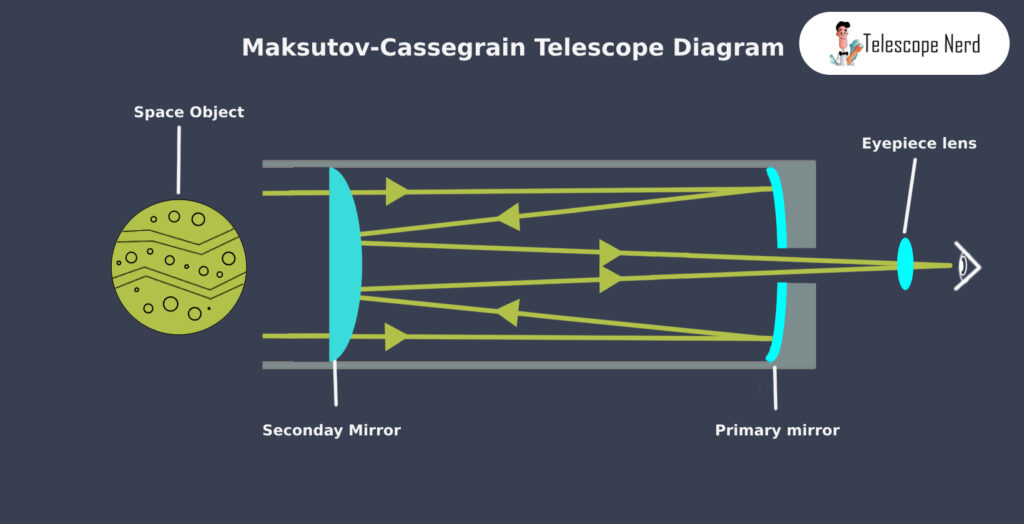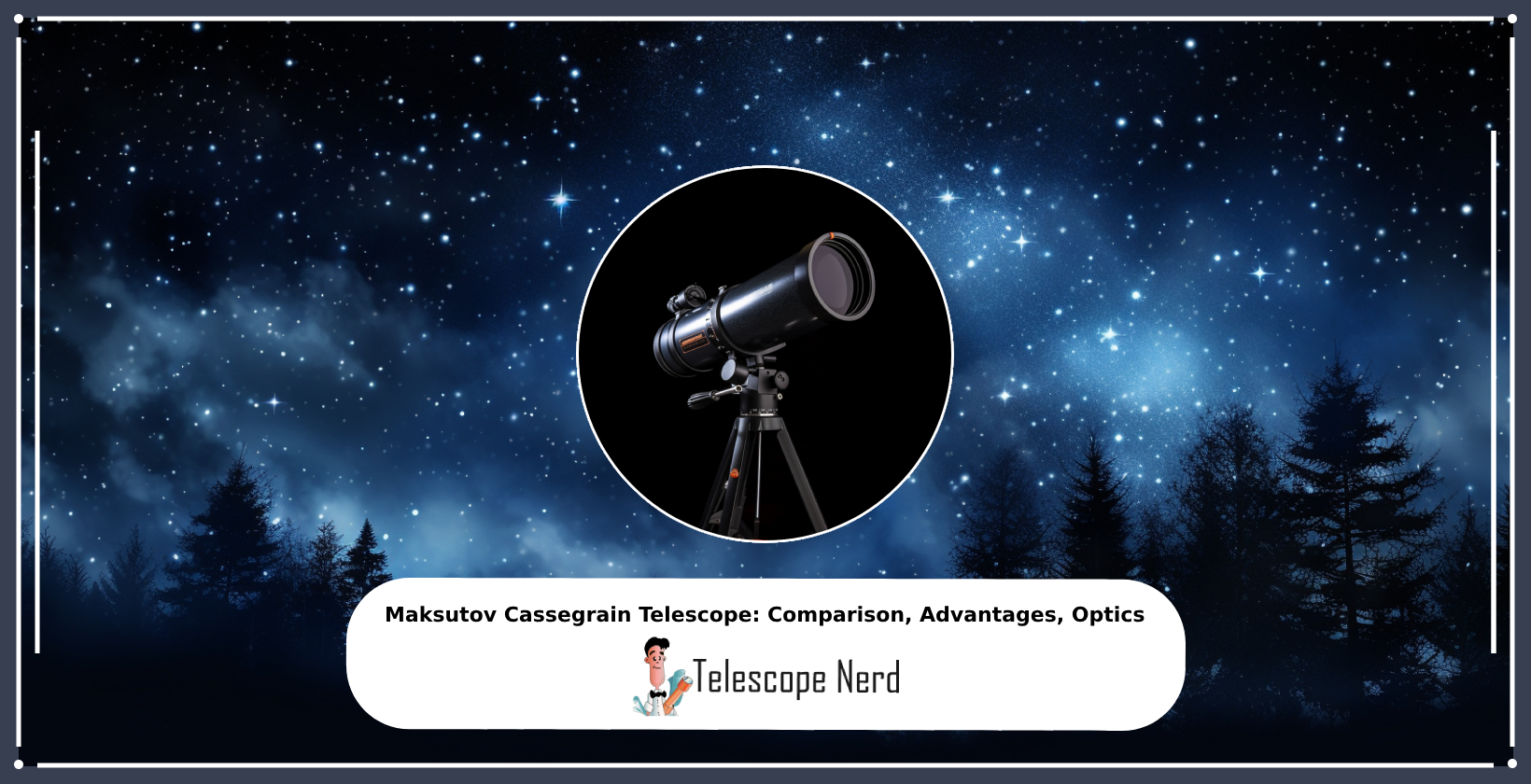Maksutov Cassegrain Telescope: Comparison, Advantages, Optics
The Maksutov-Cassegrain (Mak) telescope is a type of catadioptric telescope that employs both mirrors and lenses to produce an image. Its design incorporates a thick meniscus corrector lens and a spherical primary mirror, efficiently reducing optical aberrations.
The Maksutov is recognized for delivering high contrast, particularly in planetary observation, and has become a preferred choice for viewing detailed celestial objects. The Mak’s compact nature and high-quality imaging make it a favorite among amateur astronomers and astrophotographers.
Compared to other telescopes, the Mak has a slower focal ratio, which limits its field of view. Knowing these specific strengths and limitations of the Mak guides users in determining the best model.
One major advantage of most Maksutov-Cassegrain telescopes is their high contrast and clarity, making them especially suitable for planetary observation. Maks also minimize spherical aberration, coma, and chromatic aberration. The meniscus corrector and primary mirror result in the precise convergence of light and sharp, detailed images. The potential challenges include longer cooldown times and longer focal lengths, which restricts wide-field views.
How Does the Maksutov-Cassegrain Compare to the Schmidt-Cassegrain?
The Schmidt-Cassegrain telescope (SCT) and Maksutov-Cassegrain (Mak) are based on the same foundational operation. However, each telescope caters to unique observational goals. The SCT is another type of catadioptric telescope, meaning it combines mirrors and lenses to create an image. The SCT uses a spherical primary mirror, a secondary mirror, and a corrector plate to correct spherical aberration, resulting in a compact and adaptable instrument.
The Maksutov has superior contrast, making it a top contender for astronomers eager to delve into planetary details. It often trumps the SCT when it comes to discerning intricate details on planets or the moon. However, the SCT counters with its broader field of view, attributed to its typically faster focal ratios. The wide field of view and faster optics make the SCT a preferred choice for many looking to survey vast celestial territories or engage in astrophotography.
Both designs are beneficial in certain observational scenarios, but they each have their own challenges. The thickness of the Maksutov’s corrector lens leads to longer acclimation times in fluctuating temperatures, delaying viewing sessions. The SCT, on the other hand, occasionally suffers from optical imperfections, such as coma on its edges.
The usage of the SCT and Mak both involve mounting, aiming, and focusing the telescope. However, the intricacies in their designs will result in different experiences. The Maksutov, with its weightier corrector plate, often demands more patience, especially during setup in varied temperatures. The SCT is best for those eager to explore larger areas of the sky, especially in astrophotography. Conversely, the high contrast of the Mak makes it ideal for lunar and planetary gazers.
Both telescopes work by collecting light using their primary optical elements, whether it’s the SCT’s corrector plate or the Mak’s meniscus lens. This light is then navigated towards the primary mirror, which then reflects it to the secondary mirror. This secondary mirror, in turn, focuses the light out towards the eyepiece. The quality of these optics, among other factors, will determine the best Maksutov Cassegrain telescope.
What are the Best Maksutov Cassegrain Telescopes?
The best Maksutov-Cassegrain telescopes are determined based on their use, performance, quality, and popularity. The Maksutov-Cassegrain telescope is an altazimuth-mounted reflector, catering to a range of observational needs.
The best Maksutov-Cassegrain telescopes will depend on the intended use. For example, large-aperture Maksutov-Cassegrains are best for observers exploring detailed views of deep-space entities. However, a compact Maksutov-Cassegrain is best for those who travel often due to the ease of transport and setup across different terrains.
The performance of a Maksutov-Cassegrain telescope predominantly relies on its mirror quality and diameter. Larger diameters capture more light, resulting in brighter and more detailed celestial images. High-quality mirrors also minimize optical aberrations, ensuring clear observation.
The best Maksutov-Cassegrain telescopes feature robust, balanced mounts that facilitate fluid movement. The optical tube, which houses the mirrors, must be durable and shield the internal components from external contaminants, such as dust and impact.
The community’s reception of a telescope also offers insights into its worth and reputation. The most esteemed Maksutov-Cassegrain telescopes garner acclaim from astronomers for their performance and durability, allowing others to identify their advantages and disadvantages before purchasing.
What Are the Advantages of Maksutov-Cassegrain Telescope?
The Maksutov-Cassegrain telescope uses a unique combination of mirror and lenses to deliver high-quality images. The 4 most distinct advantages are given below.
- High Contrast
- Reduced Optical Aberrations
- Robustness
- Minimal Maintenance
The Mak is known for its high contrast, particularly during planetary observation. This is attributed to its meniscus corrector plate, which, when combined with the primary mirror, provides detailed and clear images of celestial objects.
The Maksutov-Cassegrain telescopes also effectively minimize spherical aberration, coma, and chromatic aberration. This is because of the combined effects of the meniscus corrector and the primary mirror, which ensure a precise convergence of light, enhancing image clarity.
The Mak’s sealed design, achieved through its meniscus corrector plate, protects the internal optics from the external environment. This ensures longevity and decreases the likelihood of internal components being affected by dust or other particulates.
The Maksutov-Cassegrain generally requires less frequent cleaning and maintenance because of its sealed tube design. The risk of dust accumulation or moisture seepage is diminished, ensuring that the optics remain pristine over extended periods.
What Are the Disadvantages of Maksutov-Cassegrain Telescope?
The 4 most notable limitations of the Maksutov-Cassegrain telescope are given below.
- Slower Focal Ratio
- Longer Cooling Time
- Restricted Field of View
- Weight
The Mak typically possesses a longer focal length, which results in a slower focal ratio. This characteristic limits its field of view, especially when compared to other telescopic designs.
The Maksutov-Cassegrain’s design, with its thick meniscus corrector plate, necessitates extended cooldown to achieve thermal equilibrium with the external environment. This will impact the quality of initial observations, especially during temperature fluctuations.
Because of its slower focal ratio, the Mak’s design often provides a more narrow field of view, making it less suitable for wide-field observations such as expansive nebulae or larger star clusters.
Due to the materials and the thickness of the corrector plate used, the Mak is generally heftier than other telescope designs of similar apertures. This presents challenges in terms of portability and mounting requirements.
While the Maksutov-Cassegrain offers exceptional clarity and reduced maintenance, it’s important to weigh in both the pros and cons. Choosing between the Mak and other designs, such as the SCT, will depend on the specific observational goals and preferences of the user. To understand the optimal design for one’s goals and preferences, it’s important to consider how these designs work.
How Does Optical Design Work in a Maksutov-Cassegrain Telescope?
The Maksutov-Cassegrain telescope works using an intricate interplay of both refractive and reflective optical components to capture and focus light. At the forefront of the Mak’s design is the meniscus corrector plate. As light first makes its entry into the telescope, it’s channeled through this curved corrector plate. The primary function of this plate is to eliminate the challenges posed by spherical aberration and set the stage for the collimation of incoming light rays.

Once the light has maneuvered through the corrector plate, it finds its path directed toward a concave primary mirror placed strategically at the telescope’s rear end. This mirror’s primary role is to catch the incoming light and reflect it back toward the center of the telescope. The center of this primary mirror is silvered, taking on the role of a secondary mirror. This unique design element ensures that the previously reflected light isn’t wasted but is instead redirected outwards, undergoing further focusing in the process.
The light then exits the telescope through a side opening. In this opening, light encounters the eyepiece, which performs the final touch-ups, producing a detailed and sharp image that the viewer perceives. The Mak’s distinct optical design makes it an exceptional instrument for viewing and underlines its compactness. The design folds the optical path, providing a portable and powerful observational experience.
Is the Maksutov-Cassegrain Telescope Difficult to Use?
No, the Maksutov-Cassegrain telescope is not difficult to use. The hallmark of this type of telescope is its combined lens-mirror system, designed for straightforward image clarity and focus. While there is a learning curve, as with any optical device, the Mak’s design is largely user-friendly and intuitive, particularly for those seeking detailed planetary observations.
To initiate the viewing process, users should mount the telescope securely on its base. Once in place, the telescope is to be aimed toward the desired celestial body. Using the focusing mechanism, viewers are then able to refine the image for optimal clarity. Over time, due to Earth’s rotation, the celestial object drifts from the field of view, and the user will need to make periodic manual adjustments. Because of this, Maksutovs have garnered a reputation of both positive and negative attributes.
Is Maksutov Cassegrain The Most Popular Type of Telescope?
No, the Maksutov-Cassegrain is not the most popular type of telescope in the astronomy community. The popularity of a telescope type often varies based on specific needs, regions, and experience of the user.
Different telescope types, including the Dobsonian, Newtonian reflector, and the Schmidt-Cassegrain, frequently compete for the title of “most popular” depending on the context. For instance, Dobsonians are generally favored by beginners due to their simplicity and cost-effectiveness, while research institutions lean towards specific models that cater to their specialized requirements.
The Mak, with its distinctive meniscus corrector plate at the front, excels in providing sharp, high-contrast images, especially for planetary viewing. However, in terms of sheer numbers and widespread use, it won’t surpass other models in global popularity. It is essential to understand that popularity is not always dictated by quality, as it is also influenced by cost, intended use, and regional availability.













